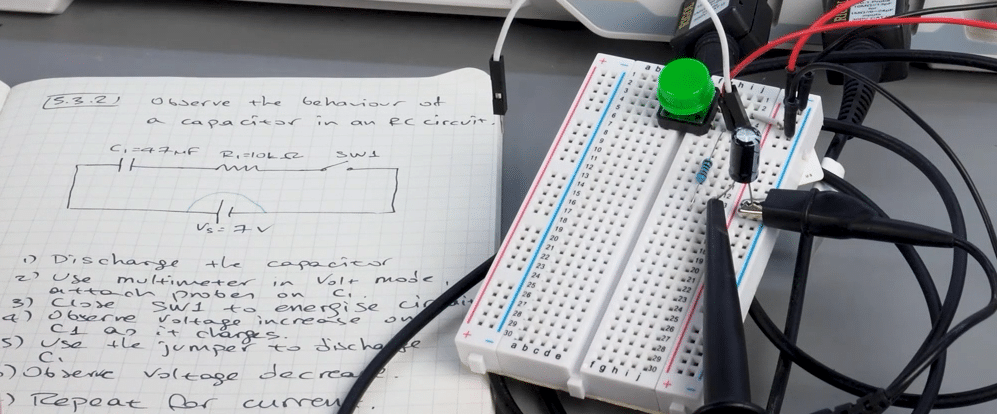ELECTRONICS guide series
Introduction to Electronics Basic tools in electronics
This guide will help you understand electronic circuits—the fundamental building blocks of modern technology. Electronics are all around us, embedded in countless devices we use daily, and it all starts with these circuits.

Basic tools in electronics
Let's turn our focus on the fundamental toolkit you will need to work with electronics. These tools will help you to build, test, and troubleshoot electrical circuits and electronic components.
Let's take a closer look at each one of them.
Multimeter
One of the most versatile instruments you'll encounter is the multimeter. This device is used to measure voltage, current, and resistance – the core concepts of electrical engineering.
By selecting the appropriate function and range of voltage or current, you can use it to troubleshoot electrical circuits, test batteries, or check the continuity of a wire or circuit board.
It can also provide you with the voltage transfer characteristics for diode circuits and other semiconductor devices. A multimeter is indispensable for both basic and advanced work with electric circuits.
Breadboard
The breadboard, is a fantastic tool for prototyping and experimenting with electronic circuit designs.
Breadboards have a grid of holes where you can insert electronic components and wires without the need for soldering. This allows for a plethora of potential arrangements of components, facilitating the study of basic circuit concepts, as well as the testing of complex circuit designs.
Understanding breadboard layout and usage is a foundational skill for any budding electrical engineer or electronics hobbyist.
Soldering iron
For putting together a more permanent electronic circuit, a soldering iron is required. This tool is used to solder electronic components to a printed circuit board (PCB). When the soldering iron heats the solder, it melts and flows around the connection, creating a durable electrical bond between the component and the board. Proper use of a soldering iron is essential for reliable circuit construction.
In this course we will do all experiments on a simulator and a breadboard, so you will not need a soldering iron at this point.
Wire strippers
Wire strippers are used to remove the insulation from electric wires so that the conductor can be connected to other wires or components. They are especially important when dealing with various wire gauges in electrical power and signal connections. Accurate and clean stripping is crucial to avoid damaging the wire’s conductor.
Tweezers
Tweezers are very helpful when trying to place and manipulate small components on circuit boards. They come in different shapes and sizes to accommodate the wide array of electrical components you might encounter. I use a collection of tweezers with different shapes and sizes of tips, all of them with antistatic properties to prevent damaging sensitive components like integrated circuits.
Magnifying glass or headset
Many electronic components are tiny. To see the fine details of your electronic components and solder joints, a magnifying glass or a magnifying headset is a huge help. This helps ensure that components are placed accurately and that solder joints are made correctly without any bridges or cold solder joints. Also, along with a magnifying glass or headset, be sure to use adequate lighting on your workbench.
Power Supply
A reliable power supply provides a stable source of electricity at various voltages and currents to an electronic circuit. It's used to power and test circuits without the need for batteries, giving a constant and adjustable electrical power supply needed for amp circuits, integrated circuits, and much more.
On my workbench, I have two identical power supplies so that I can have two simultaneous power sources.
If you don't want to invest on a dedicated bench power supply, you can get away with batteries. For the purposes of this course, batteries will be sufficient.
Component Organizer
Staying organized is essential in electronics work. Without a basic level of organisation, your component will tend to disappear, and you will spend more and more time trying to find them (without success).
A component organizer will help you keep electronic components and small parts tidy and readily available for your projects. This prevents loss and damage to electrical components that are essential to your work.
INTRODUCTION TO ELECTRONICS THE BASICS
A comprehensive course to help you start your adventure in electronics. Solve circuits, simulate, and experiment on the breadboard.
Are you ready to dive into the fascinating world of electronics? Whether you're a hobbyist looking to build your first circuit, a student seeking a deeper understanding of how electronics work, or a professional expanding your skillset, this course is your gateway to mastering the essentials of electronics.
Jump to another article
1. What is this course about?
2. Hardware
3. Software
4. Course organisation and study guide
5. What are electronic circuits?
6. What is electricity?
7. Key principles in electronics
8. Direct Current (DC) and Alternating Current (AC) circuits
9. Analog and Digital Electronics
10. Introduction to electronic components and tools
11. Resistors, quick introduction
12. Capacitors, quick introduction
13. Inductors, quick introduction
14. Diodes, quick introduction
15. Transistors, quick introduction
16. Integrated circuits, quick introduction
17. Circuit boards, quick introduction
18. Breadboards, quick introduction
19. Ohm's Law, quick introduction
20. Basic tools in electronics
21. Circuit simulators
Last Updated 9 months ago.
We publish fresh content each week. Read how-to's on Arduino, ESP32, KiCad, Node-RED, drones and more. Listen to interviews. Learn about new tech with our comprehensive reviews. Get discount offers for our courses and books. Interact with our community. One email per week, no spam; unsubscribe at any time
